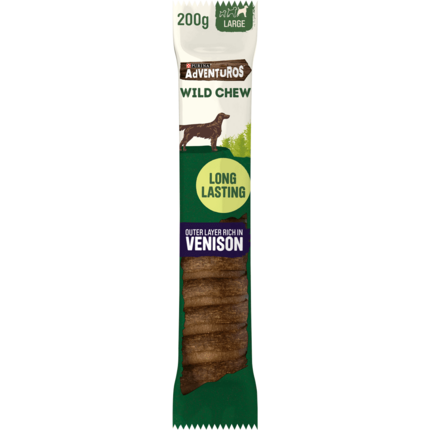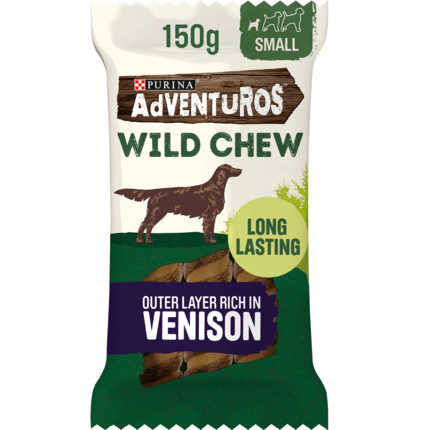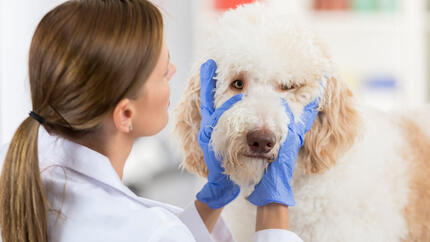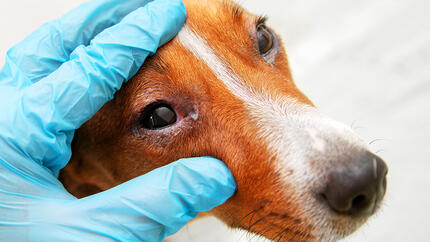Eye Drops for Dogs: Types & When Do Dogs Need Them
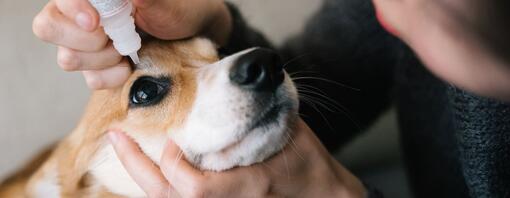
Like us humans, our furry friends also need eye care from time to time. This can include using eye drops for a variety of different reasons. You might even be wondering ‘why are my dog’s eyes red?’ and if your pup needs eye drops.
Read on to find out why your dog might need eye drops and the different types of eye drops for dogs.
Why does my dog need eyedrops?
If you notice your dog pawing at their eyes or if you can see a physical difference in one or both, your pup might need eye drops. There are a few reasons your dog’s eyes might look like they’re in need of some TLC. Check out our list of reasons and always remember to consult a vet if you suspect any of these issues.
Allergies
Of course, we all know the trials and tribulations of hay fever season and other allergies we may have. Unfortunately, our pups can also suffer from seasonal allergies, allergies to household cleaners, shampoos and any other products we use. Eye drops for dogs could be recommended if these eye symptoms persist:
- Redness
- Squinting
- Clear, watery discharge
- Swelling
- Pawing at eyes
- Light sensitivity
Don’t hesitate to check with your vet if you suspect your dog is suffering from an allergy.
Various dog eye infections
Dog eye infections can be an issue that your pup can face, which could need treating with eye drops prescribed by a vet. From cherry eyes to weepy eyes, a dog’s eyes can be telling you something is wrong if they have the following symptoms:
- Squinting
- Redness
- Itching or pawing at eye
- Eyelid swelling
- Blinking a lot
- Discharge
Glaucoma
Canine glaucoma is a condition characterised by high pressure inside the eye. It is a very painful condition that often causes blindness, especially if it’s left untreated. When glaucoma develops, urgent veterinary treatment is essential. Unfortunately, it can’t be cured but it can be managed with eye drops for dogs to preserve eyesight as long as possible. Signs of glaucoma include:
- Severe eye pain
- Cloudy/blue eyes
- Weepy eyes
- Blindness
- Redness
- Bulging eyes
- Uneven pupils
Conjunctivitis
Conjunctivitis in dogs can be caused by infection, irritants, dust mites, trauma or an underlying health condition. Signs of conjunctivitis may include:
- Redness or inflammation
- Puffiness
- Green or clear discharge from eye
- Squinting
Other eye infections or issues
There are a few more issues where eye drops for dogs can be beneficial, including:
- Keratitis
- Dry eyes
- Trauma
- Keratoconjunctivitis sicca (KCS)
- Corneal ulcers
Remember to always consult a vet without delay if you think your pup is suffering from any of these issues so they can prescribe the right eye drops for the most effective treatment.
What are the different types of eyes drops for dogs and what do they contain?
Your vet will prescribe different treatment, depending on the issue your dog is suffering from, because eye drops contain different ingredients and have different effects. This is to ensure your dog is getting the best, and most effective, treatment for their issues.
Saline eyewashes
Saline washes are used to clean dirt from your dog’s eyes. Another benefit is that it removes all the gunk that can gather in the corner of your dog’s eyes! Because this just clears out debris, however, this is likely not beneficial for more complex eye issues.
Steroid eye drops
For severe allergies and other eye infections, steroid eye drops might be prescribed by your vet. Steroid eye drops cannot be used if the cornea is damaged, so your vet may apply a special stain to your dog’s cornea to make sure everything is OK.
Glaucoma eye drops for dogs
If your dog is diagnosed with glaucoma, it is likely to be prescribed eye drops to start without delay. These may contain active ingredients such as timolol brinzolamide or dorzolamide.
Antibiotic eye drops
For issues like conjunctivitis or keratitis, which may be caused by an infection, antibiotic eye drops for dogs could be prescribed.
Other ophthalmic medications
Other ophthalmic medications include those used to treat dry eyes in dogs. Medications used to treat dry eye include those containing cyclosporine or tacrolimus and they are designed to increase tear production and replace the tear film.
How to apply eye drops for dogs
Now that you know all about eye conditions and eye drops for dogs, how do you apply them? So that your dog can receive the right dosage of medicine and heal properly, it’s important to follow the instructions given by your vet and the instructions on the bottle.
Here are 5 steps for applying eye drops to dogs:
- Wash your hands thoroughly before and after.
- Use a wet and warm washcloth to clean the area around your dog’s eye gently.
- Cradle your dog’s head (or have a trusted assistant to help with this).
- Using your dominant hand, hold the medicine bottle with your thumb and index finger. Pull down your dog’s lower lid with your other thumb. If you’re doing this alone, the rest of your fingers on that hand can support your dog’s jaw.
- Without touching the eye, place the bottle close to the eye and squeeze the prescribed amount into the centre. Naturally, your dog will blink a few times, which helps to spread the medicine around the eye.
A process like this might require a treat after you’re done! And remember to give lots of praise.
Eye drops for dogs: which breeds are more likely to need eye drops?
Some breeds are pre-disposed to eye conditions. This means that they may be more likely to need eye drops. Here are some examples:
Corneal ulcers: brachycephalic breeds
Due to the shape of their face, brachycephalic dogs, like pugs and Persian cats are at increased risk of corneal damage and ulceration.
Dry Eye: Terriers, Spaniels, and Pugs
In dogs, a lot of cases of dry eye are inherited (passed from parent to puppy). This is why it’s common in certain breeds like:
If you think your dog is suffering from any kind of eye condition, remember to consult a vet before administering any kind of eye drop. We only want the best treatment for your pup!
There are situations where you might be caring for a blind dog as your old-age companion is losing their sight. Find out how to care for your blind dog, next.







